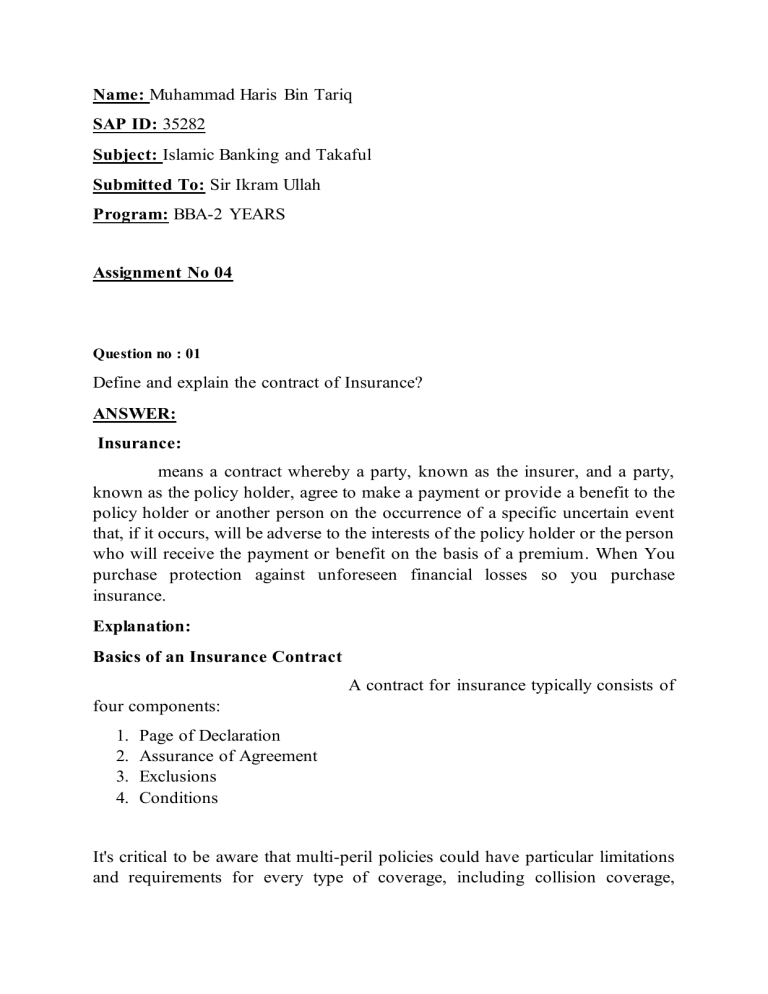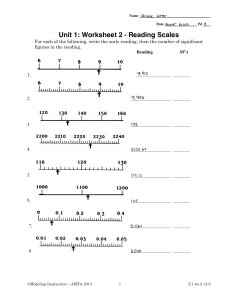
Name: Muhammad Haris Bin Tariq SAP ID: 35282 Subject: Islamic Banking and Takaful Submitted To: Sir Ikram Ullah Program: BBA-2 YEARS Assignment No 04 Question no : 01 Define and explain the contract of Insurance? ANSWER: Insurance: means a contract whereby a party, known as the insurer, and a party, known as the policy holder, agree to make a payment or provide a benefit to the policy holder or another person on the occurrence of a specific uncertain event that, if it occurs, will be adverse to the interests of the policy holder or the person who will receive the payment or benefit on the basis of a premium. When You purchase protection against unforeseen financial losses so you purchase insurance. Explanation: Basics of an Insurance Contract A contract for insurance typically consists of four components: 1. 2. 3. 4. Page of Declaration Assurance of Agreement Exclusions Conditions It's critical to be aware that multi-peril policies could have particular limitations and requirements for every type of coverage, including collision coverage, medical payment coverage, liability coverage, and others. The text of the specific coverage that applies to your loss must be reviewed carefully. 1. Page of Declaration: Usually, the first page of an insurance policy is this one. It specifies the insured, the risks or items covered, the policy limits, and the duration of the policy (i.e. time the policy is in force).For instance, the details of the car covered (such as the make, model, and REG number), the name of the person insured, the premium amount, and the deductible will all be listed on the Declarations Page of an automotive policy (the amount you will have to pay for a claim before an insurer pays its portion of a covered claim).The name of the insured individual and the policy's face amount (such as RS25,000, RS50,000, etc.) will both be listed on the Declarations Page of a life insurance policy. 2. The Insuring Agreement: This lists what is covered as well as a summary of the insurance company's main guarantees. The insurer commits to a number of actions in the Insuring Agreement, including paying damages for covered dangers, offering particular services, or agreeing to defend the insured in a liability litigation. There are two fundamental types of insurance contracts, only the hazards specifically mentioned in the policy are covered under named-perils coverage. The risk is not covered if it is not listed.All damages are covered with all-risk insurance, barring those that are expressly excluded. The loss is covered if it is not exempt. Most life insurance plans are full-risk plans. 3. The Exclusion: Exclusions void the Insuring Agreement's coverage. There are three main categories of Exclusions: Omitted risks or sources of loss Absent losses Excluded assets Flood, earthquake, and radioactive radiation are some instances of risks that are not covered by a homeowner’s policy. Wear-and-tear damage is a common illustration of an excluded loss under an automotive policy. Personal property like a car, a cat, or an aeroplane is an example of excluded property under a homeowner’s policy. 4. The Conditions: Conditions are clauses included to the policy that limit or qualify the insurer's obligation to pay or perform. The insurer may reject the claim if the criteria of the insurance are not met. Common policy conditions include the need to submit a proof of loss to the insurer, to safeguard property after a loss, and to cooperate with the insurer during an investigation or the defence of a liability claim. The policy limit is the highest sum that an insurer will cover for a covered loss under the terms of the policy. Maximums may be determined by time period (such as annually or during the term of the policy), by loss or damage, or during the policy's lifetime, often known as the lifetime maximum. Higher limits typically come with higher rates. The face value of a general life insurance policy refers to the highest sum that the insurer will pay; this sum is given to a beneficiary upon the death of the insured. Question No: 02 Differentiate between Risk and Uncertainty? ANSWER: RISK: A risk is an unforeseen circumstance that, if it happens, could have an impact on one or more of your project objectives. The risk is considered positive if it has a good impact on your project and negative if it has a negative one. For negatives and positives, different risk response strategies exist. A positive risk response strategy seeks to increase chance or impact, whereas a negative risk response strategy seeks to limit impact or probability. Two additional risk concepts might be mentioned: known and unknown. Unknown risks are those you were unable to find, while known risks are those discovered during the identify risks procedure. For recognised hazards, a contingency plan is created, and you'll use the contingency reserve to manage those risks. Unknown risks, however, are dealt with by finding a solution and employing the management reserve. Uncertainty: Lack of absolute certainty is what uncertainty is. When there is uncertainty, no outcome of an event can be predicted or quantified because you don't know anything about it beforehand.It is not a risk that is unknown to exist.Even though an event has been identified, you are utterly unaware of its history while you are in an uncertain situation. Even though you have the background knowledge in the instance of an unknown risk, you overlooked it throughout the identify hazards method. Example of Risk and Uncertainty: Assume two illustrious teams illustrious players will engage in a football match the following day. with Which team will win, exactly, and can we tell? No, we can't. However, by evaluating and examining the historical performances of each player, the team, and the outcomes of the matches they played against one another, you may make an educated guess. Then you may calculate certain probabilities, such as a 30% likelihood of either Team A or Team B winning or a 70% chance of either Team A or Team B losing the match. Let’s now place the identical football game in a different circumstance. Let’s pretend once more that there are no players chosen for either team or that there will be a game between two teams. What would you say if someone asked you which team will win in this scenario? You won't know which team contains which players, and you won't know how the teams will do, thus you won't know anything. Even though the regulations and the stadium are the same, you cannot forecast the outcome of the event since you lack knowledge of previous results. We refer to this circumstance as uncertainty. Risk vs Uncertainty: There are a few ways that risk and uncertainty differ from one another. In contrast to uncertainty, where it is impossible to anticipate future outcomes, risk allows for this. While uncertainty is unpredictable, risks can be managed. While uncertainty cannot be quantified or assessed, risks may. Risky occurrences can have a probability assigned to them, but uncertain events cannot. Main Difference between Risk and uncertainty Comparison Basis Risk Uncertainty Definition An event, if occurs, can affect any project objective. There is no information about the future event, or impact. Key Feature Risk can be measure Uncertainty cannot be Measured. Control As the outcomes are known, risk can As the outcomes are unknown, be controlled. uncertainty cannot be controlled. Probability Risks have the probability of occurring. Question No: 03 What are the ways of Handling Risks? ANSWER: There are Five Ways of Handling Risks. 1. 2. 3. 4. 5. Risk Risk Risk Risk Risk Avoidance. Retention. Reduction. Transfer. Sharing. Probabilities of uncertainties cannot be guessed. 1. Risk Avoidance: Risk cannot always be totally avoided, but it should always be considered a possibility. To reduce the risk of vehicular accidents during bad weather, Physical Plant, for instance, can delay releasing vehicles for travel until the weather starts to clear. On campus, some buildings have experienced recurring water issues. Some water damage claims might be prevented by forbidding the storage of documents or supplies in those locations. 2. Risk Retention: Even though there are other ways to handle the risk, on occasion keeping the risk, or a portion of the risk, may be cost-effective depending on the frequency and severity of the dangers posed. For instance, due to the difficulties in identifying and assessing each of these many types of structures, the University retains the risk of loss to fences, signs, gates, and light poles. Except in cases where third parties were negligent, the cost of repairs is covered by the campus maintenance budget when losses occur. Despite the availability of insurance, the University nonetheless bears the risk of loss for the majority of University personal property. 3. Risk Reduction: When risk cannot be eliminated, it is frequently possible to reduce it in terms of frequency and intensity. For instance, to lower the danger of theft, Risk Management promotes the deployment of security systems on certain audio visual equipment. Students who are studying abroad are required by the university to acquire health insurance in order to reduce the possibility of them running into financial trouble if they need medical attention overseas. 4. Risk Transfer: Risk can occasionally be transferred to another party, usually through a contract. In order to transfer the risk of the event from the university to the facility user, outside organisations who utilise university facilities for open events are required to show proof of insurance and add the university to their policy as an additional insured. Since the policy really transfers the financial risk of loss from the covered entity to the insurance company contractually, the act of purchasing insurance is also known as a risk transfer. Insurance should only be utilised as a last resort and only after all other options have been considered. 5. Risk Sharing: Employer-based benefits that enable the business to split the cost of insurance premiums with the employee are frequently used to implement risk sharing. In essence, this involves the corporation and each employee who takes use of the insurance benefits sharing the risk. It is believed that when more people share the risks, the cost of premiums should decrease proportionally. It may be in people's best interests to share the risk by selecting employer-sponsored health and life insurance plans when it is feasible.






